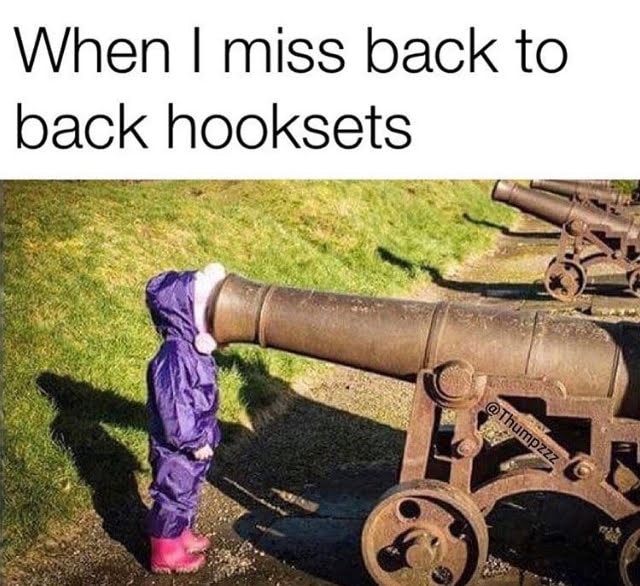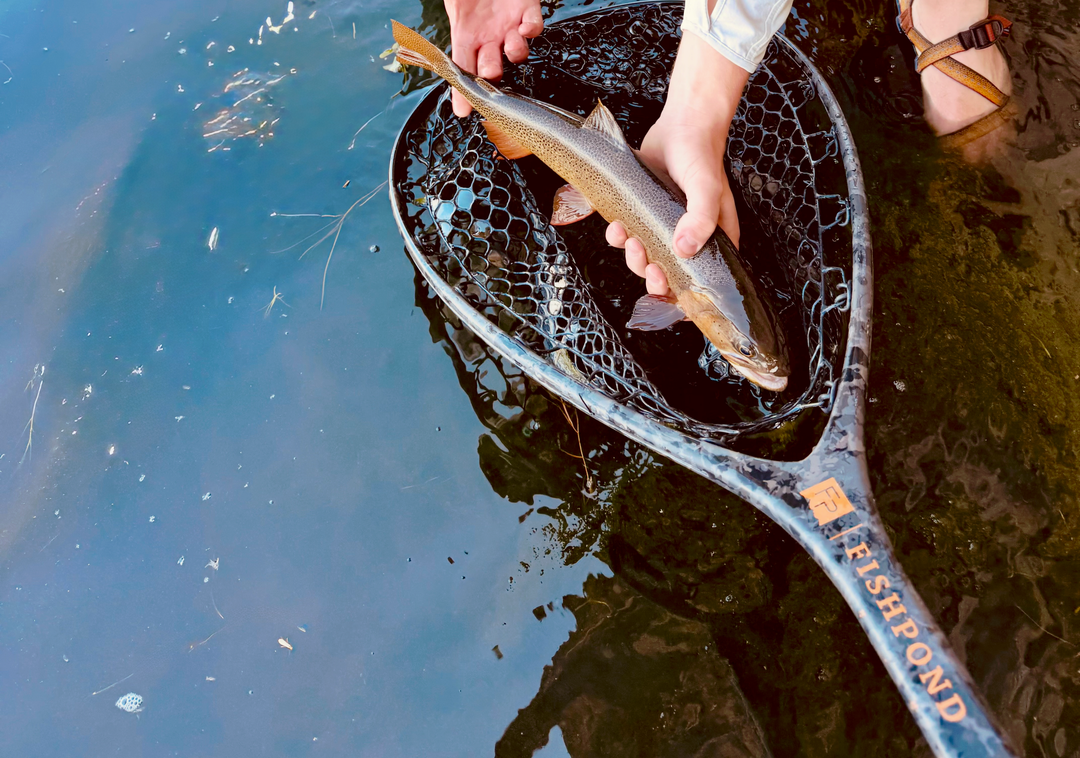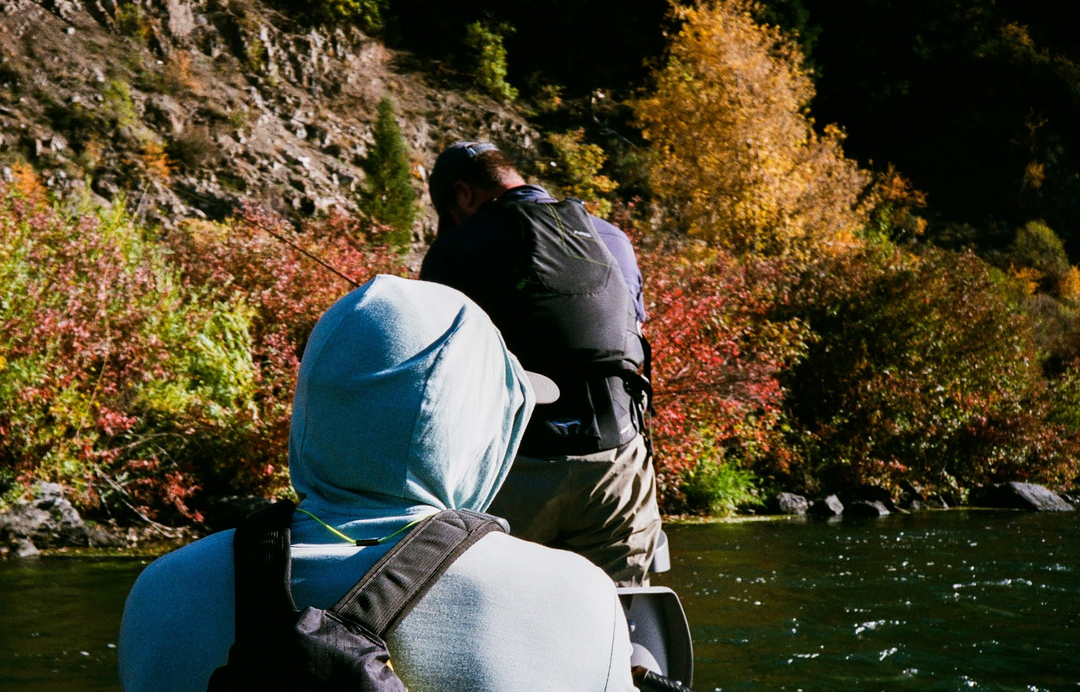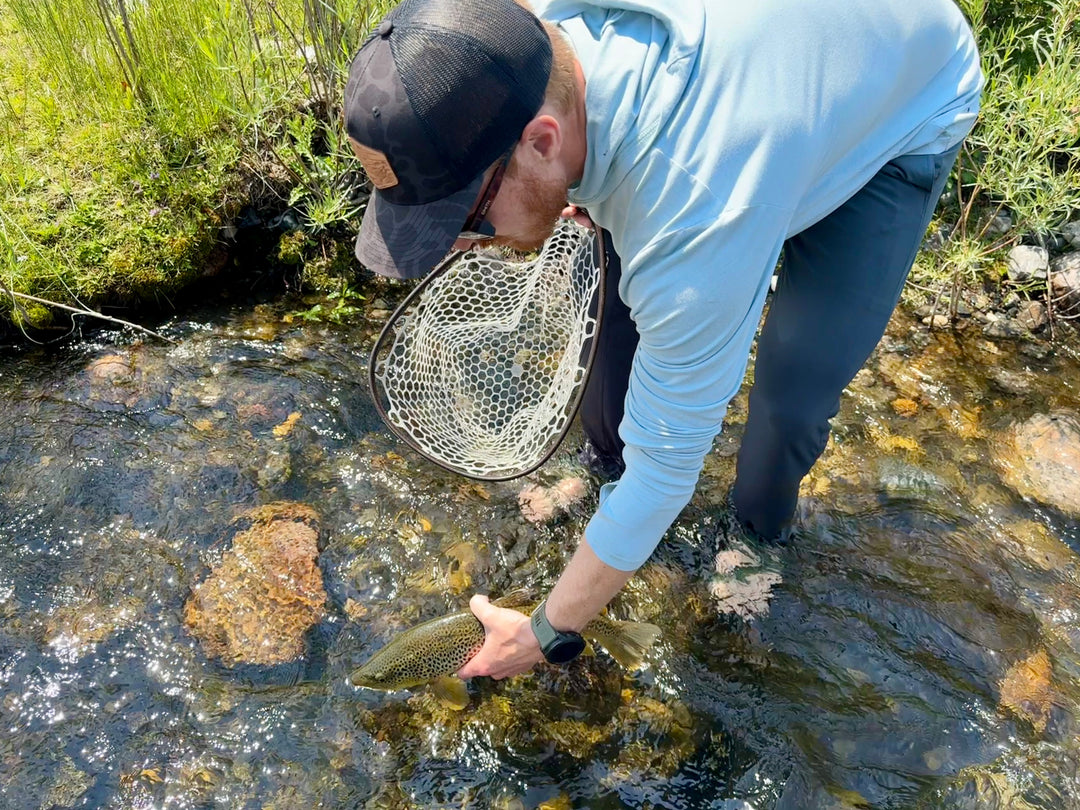Why I Sold My $1,000 Fly Rods

Background - Who the Hell Am I?
The title of this blog post is pretty self-explanatory, but let me give you some background on who I am and why I think my opinion is relevant to most of the people reading this. To be clear, this article is aimed at younger and more inexperienced anglers. If your kids are out of the house, you're at the later end of your career, and you've got cash coming in, then go ahead—buy a beautifully crafted handmade Scott fly rod. You'll love it. I still have several! I love my Radian, G-Series, Centric, and F-Series (which will be buried with me when I die). But this article isn’t aimed at you. That said, the lessons I’ve learned along the way are still worth considering.
My name is Brad Buchanan. I've been in the outdoor industry for nearly 15 years in some form or fashion—whether full-time, part-time, after hours, or on the weekends. I've loved the outdoor industry and have always tried to keep my foot in the door in some capacity. In college, I worked at climbing gyms and bike shops and even biked across the country (literally). After college, I spent a couple of years working at REI—first full-time and then part-time on weekends and after hours once my full-time job wrapped up for the day. Once I moved out West, I started working in the fly fishing industry, specifically in manufacturing fly fishing rafts.
Ironically, I didn’t fish much while working in the fly fishing world, but when I transitioned back to the tech world, I suddenly had immense freedom with the work-from-home life. I have proceeded to spend 150+ days a year in the mountains, deserts, streams, and rivers of the Rocky Mountain West. It was during this period that I was finally able to put all those years of work and experience to the test—day after day, week after week, month after month.
So while I haven’t been a fishing guide for the last 10 years, I've been in and around the outdoor industry for a long time. I've had the privilege of watching the best in the business, learning from them, and developing my own skill set along the way. Being in the outdoor industry, I felt the need to take an exorbitant amount of pride in the tools I used. So I set out to outfit myself with a quiver of $1,000 fly rods. In retrospect, considering how little the outdoor industry pays—often with terrible or no benefits—spending all my money on thin pieces of graphite was an absolutely moronic decision.
I partly made this decision because, while I was at REI, Arc'teryx offered employees 85% off retail once a year before the holidays. REI (at least when I worked there) did 25% of their annual revenue in the month of December. By giving their employees top-tier gear for next to nothing, Arc'teryx ensured that everyone was decked out in their products—and when sale season came, guess what brand employees pushed? Arc'teryx. At the time, Arc’teryx was leaps and bounds better than most of the other gear I had access to, and I still, over a decade later, I still use the four pieces I bought. That’s the kind of value that justifies a high price tag.
Coming from the climbing industry, I assumed that $1,000 rods would have a similar effect—that they would be the Arc'teryx equivalent of the fly fishing world. But after years of using multiple $1,000 rods, I’m here to tell you that the difference isn’t that big. In fact, I’ll go so far as to say that buying those rods may actually inhibit you from becoming a better angler. The one thing most anglers will truly notice about a $1,000 rod is that it's lighter than its cheaper counterparts. Other than that, if you blindfolded most anglers, they would never be able to tell the difference between a $1,000 rod and a $500 rod.
So What Changed?
Several things came together to change my perspective on the value of a $1,000 fly rod versus they're substantially more affordable siblings. These were:
-
The Repair Process and Cost
-
My 2024 Season
-
Fishing More with Fly Fishing Guides
I'll run you through how the warranty process should impact your purchasing decision by providing a little bit of background into my experiences using several different brands repair process. Then we'll take a short walk down memory lane to review how my 2024 season impacted my opinions on these premium rods. Finally, and probably the most influential, was the time I spent around guides.
The Repair Process and Cost
You may be thinking "Don't you mean warranty process not repair process?" and the answer to that would be no. I mean repair process because the overwhelming majority of the time we just break the rods. In fact Tim Kirkman wrote this really informative article on how 95% of rod failures is due to misuses or abuse. So knowing the 95% of the time a rod breaks it's my fault just adds insult to injury when we talk about the real reason that $1,000 rods started to frustrate me.
The number one thing that has turned me off $1000 rods is the repair process and more specifically the timeline it takes to get them repaired. This isn't always the case, but most $1000 rods are hand made which means that they typically need a part made by hand to match your specific rod. You can't just get a tip section sent out like most more affordable rods to replace it because it won't be exactly matched to that rod. Because of this it can take weeks to months to get a rod repaired and back in your hands. You have to account for shipping time to the manufacturer, they have to work through all the other repairs that are in line before you, then finally fix your rod, then ship it back to your house.
I fish year round so losing a month or two doesn't suck in the span of 12 months, but if you are a warm weather fisherman like a lot of folks that means your season is probably realistically 6 months long. Losing 2 months of a 6 month season really sucks, especially if you have a big trip planned and wanted or needed to use that rod on that trip.
Quick Tip on Shipping Rods
If you’ve sold a rod or need to send one back for repair, use a company called PirateShip.com. This is how I ship all my rods, and it’s a fraction of the price of UPS/USPS. Essentially, you cut UPS out of the equation—you still ship with UPS, but by printing labels and packing everything yourself at home, you can save a pretty penny. For instance it cost me $65 to send a rod from Salt Lake City to Colorado, with PirateShip I was able to send a rod to the New England area that I sold for $28. That's a big difference!
Streamer fishing is my favorite style of fly fishing and I wanted to get a new streamer rod for 2024. I picked up a really beautiful $1,000 rod and on my first float my buddy accidentally press the wrong button on his truck's power sliding rear window and instead of opening them for us to grab the rods he proceeded to close them and cut both fly rods in half. Which meant in the span of about two seconds I was out two rods, with lead times of upwards to 16 weeks. Both of my streamer rods were very cleanly cut in half about a week before the spring season really kicked off. Now you can streamer fish with other weight rods but streamer fishing with four or 5 weight fly rods is just not really all that fun when compared to using six and seven weights for the last several years.
I was out both of my streamer rods and I wasn't gonna be able to fish the way I love for up to 4 months. This left me with the options of either buying new rods or just fishing other ways which simply wouldn't do so I found a rod that fit the budget I had and bought it so my season wouldn't be ruined while these others got repaired. The repair timeline started to unravel the allure to $1,000 rods, but fishing this cheaper rod pretty much blew that appeal out of the water.
My 2024 Season
2024 was the best fishing season I’ve had to date, and it’s not even close. The ironic thing? Every single one of my biggest fish—and all the fish I was most stoked to catch—were landed with a rod that never cost more than $500 and I had probably 6-10 $1,000 rods at the time.
For the overwhelming majority of the year, I was using the Kelly Galloup Streamer X rod from Echo. It turned out to be the perfect rod for my fishing adventures, and I actually liked it more than the $1,000 rod my buddy accidentally cut in half. We did end up breaking one of these rods after a frustrating section of a float causing me to overloaded a hook set following three missed hooksets in a row.

The beauty of Echo's Repair Process though was that once I broke the rod and submitted the repair information, I had a new piece in my hands by the end of the week. I was fishing with the same rod that weekend. At that point in the summer, I still had eight weeks left before getting back one of my other rods.
Then came a trip to visit friends in an unnamed western state —a guide's day off type of float. I was instructed to bring absolutely nothing. For a gear junkie, not using your own meticulously chosen equipment is a subtle shot to the heart. When we got there, we used rods and reels that looked like they had sat in the elements 250 days a year—because they had. These rods lived in clients’ hands day in and day out. To say they were "well-loved" is a drastic understatement.
That float, in particular, ended up being the best day of trout fishing I’ve ever had in my life—nothing else even comes close. We netted over 50 fish, and it felt like everything we did worked (I say "we" like I was the one coming up with the strategy and assisting in some way, but that is the reality of fishing with a guide who knows when and where the fish are eating and they happen to be on an absolute feeding frenzy. We had countless double hookups and at least 20 fish in the 20- to 22-inch range. The 18-inch fish were so thick that they looked like they could eat the 18-inch fish I catch on the Provo any day of the week.
When I look back on that trip, never once do I think about the rod I had in my hand. I think about the experience—setting the hook on a 22-inch rainbow that ripped 65 feet of line out of my hand in two seconds, watching an indicator go down, setting the hook, and thinking I had caught a log because the fish was so heavy it didn’t need to fight hard, or the countless ridiculous photos we took.
That $500 rod, beat to hell, hadn’t crossed my mind again—until this very moment, sitting here writing this. Turns you don't need $1,000 rod to make some incredible memories or even a nice $500 rod.
Hanging Around Fishing Guides
My primary fishing partner in 2024 was a seasoned guide. When you start hanging out with one guide, you inevitably get connected with others. Before you know it, you’re fishing with and learning from guides all the time. When that happens, you start picking up knowledge at an alarming rate—along with a lot of their belief systems, both good and bad - like "Waders are for Communists" or "Zin Pouches are how you actually catch fish."
One good sentiment that every single guide I fished with, in every single state, shared was this: they don’t measure their skill by the tools they use, but by their ability to teach and educate clients to catch fish. Rods are just a tool in that process. A thousand-dollar rod is rarely their first priority. That could be because they don’t make tons of money and have to work hard for what they earn, making it tough to justify dropping that kind of cash on a single rod. Or maybe it’s because they know, sooner or later, a client is bound to snap it in half.
As one guide constantly said, “I’m more of an ‘it’s the Indian, not the arrow’ type of guy.” Not the most politically correct statement, but if you’ve spent any time around guides, you know that being political correct isn’t always their strong suit.
And in his small town—where there are a health number of guides—he had won their local charity guide tournament five years in a row (if I remember correctly). And he did it all with $500 rods. Someone that fishy warrants respect. It didn’t take long for me to realize the gap between his skill level and mine had absolutely nothing to do with the price of the rod in my hand.
Honestly, I started feeling embarrassed about having these high-end rods. I felt like a fraud—like I didn’t deserve to be holding these works of art. So, I ended up ditching almost every single one of my thousand-dollar rods. And, honestly? It was liberating. I rowed harder, fished longer, and covered more miles than I ever had in previous years. And it showed. The rod was just a tool to get the job done, and I’ve never been happier.
Where Would I Spend My Money Instead?

Here’s where I’d recommend you invest your money instead of buying your first (or another) $1,000 rod:
Gas for Fishing Adventures
Spend your money on gas. Take a road trip. Drive two and a half hours away from home and fish new water. Exploring new places stokes the adventurous spirit, encourages you to get out more, and ultimately makes you a better angler. The more time you spend on the water, the faster you will improve.
I live in what I’d call a fly fishing mecca. Within an eight-to-ten-hour drive, I can hit just about every major river that’s been written about in books or magazines. But my father-in-law, who lives in St. Louis, has a favorite fishing spot two and a half hours away. It’s a commitment for him where I can be standing in a stream in 15 minutes to sneak some time in over lunch. Even though I have more access to water than I've ever had before some of my fondest fishing memories are from trips with him and my brother-in-law—not because of the rod I had in my hand, but because of the conversations in the car, the lunches by the stream, and the time spent together. Those are the moments that stick with you for life.
Guided Trips with Fly Fishing Guides

If you’ve never booked a guided trip, I cannot recommend it enough. I’ve written several articles on the benefits of fishing with guides, so I won’t belabor the point here, but if you can afford it, fishing with a guide will make you a better angler—period.
One of the best strategies for a road trip is to hire a guide on your first day, then fish on your own for the rest of the trip. A guide will give you the lay of the land, help you understand the water, and give you insight into what the fish are eating—all while delivering an absolute firehose of knowledge.
A few years ago, we went to Breckenridge for my brother-in-law’s 30th birthday and followed this exact plan. Day one with the guides was actually pretty tough, but we learned a ton. The following two days were vastly more productive because of what we picked up from them than if we just would've popped off to the same spot on our own.
Fly Fishing Books
I grew up in a house without a television. My parents—both teachers, both born in the ’50s—put a heavy emphasis on reading. As a kid, my options were pretty much: read a book or go outside. And when I was done playing outside? Reading was the only thing left.
At the time, I thought it was awful. But in retrospect, I’m grateful for it. Now, I read dozens of books each year, learning from experts on a variety of topics—including fly fishing.
One of the biggest reasons 2024 was my best season yet was because 2022 was just okay, and that frustrated me. So, I spent the entire 2022-23' winter tying flies and devouring every fly fishing book I could get my hands on. Books don’t just teach you techniques and tactics—they fuel the desire to get out on the water and put what you’ve learned into practice. And as much as we hate to admit it, time is one of the greatest skill developers.
Here are a few books that really moved the needle for me that year:
-
-
Devon Olson also has a great Youtube channel that is full of really helpful content
-
Flies & Fly Tying Material
Most anglers simply don’t have enough flies. It’s one of the biggest things holding them back.
Yes, having a basic selection will get the job done—but more often than not, you need to be fishing smaller flies (or a fly in the same family that's just slightly different). And when those smaller flies aren’t working? You probably need the same pattern in a different color. Sometimes, it’s not your tactics—it’s your tackle.
Like books, tying or buying your own flies makes you excited to get on the water and test them out. It keeps you engaged and learning, constantly refining your skills.
Fly Fishing Vehicle Rod Carrier
This isn’t a cheap option, but if you’re going to get one, buy a high-quality rod carrier from RiverSmith. I’m biased—one of my best friends was employee number one and helped launch the company—but they make the best rod carriers on the market for a reason.
Why get a rod carrier? Same reason as books. Same reason as flies. It makes it easier to get on the water.
When your rods are already rigged and ready to go, you’re much more likely to fish. I live near a lot of small creeks and streams, and when I have a 30-minute break between meetings, I can be in the water in under four minutes. That wouldn’t be possible without my RiverSmith River Quiver.

Plus, let’s be honest—fly anglers love to let people know they fish. A rod carrier is like a giant bumper sticker without the stickers. Before I got my truck I had a 2010 Toyota Corolla and I had to put all the seats down each time I wanted to put full length rods in and after switching it made zipping in and out of the canyons a breeze.
Inflatable Fishing Boat
A thousand bucks won’t get you a quality raft. And if you buy one in that price range, you’ll probably just be lighting your money on fire.
But instead of spending $1,000 on a rod, use that money as a down payment to finance a boat—or keep saving until you can buy one outright. (If you value your marriage and your wife is giving you an ultimatum, maybe take the slower route.)
A raft will completely change how you fish. It will open up new waters, help you see fisheries differently, and—ironically—make you a better wade angler, too. Plus, owning a raft attracts friends. Suddenly, people are willing to chip in for gas, beer, and shuttles—because you’re the one with the boat.
If you’re interested in finding the right fishing boat, check out this article. It’s comprehensive and should answer any question you have, no matter where you are in your search.
More Fly Fishing Rods
In general, you’re better off having a quiver of decent rods than one overpriced showpiece. Especially if you’re getting into floating, multiple rods become essential. You’ll want a setup for nymphing, one for dry flies, one for streamers—and another for streamers, because let’s be honest, it’s the most fun way to fish.
Trying to switch setups on a single rod is inefficient, especially when a hatch might only last 15 minutes and you spend 10 of them re-rigging.
Having two $500 rods is better than one $1,000 rod.
Having four $500 rods is even better than two $1,000 rods.
If you’re wondering how many rods you should have, the equation is simple: N-1, where N is the number of rods that would lead to a divorce.(Happy wife, happy life.)
Are $1,000 Fly Rods worth it?
Honestly, it depends—on your stage of life, your preferred fishing style, and your skill level as an angler. If you're still gaining experience, don't have a ton of disposable cash, or are just getting serious about fly fishing, a $1,000 rod is absolutely not the best investment. Your money will be far better spent on the things I mentioned earlier—gas, guides, books, flies, and gear that actually get you on the water more often.
That said, if you’ve got the cash to spare, I won’t argue—premium rods from brands like the Scott or G. Loomis are truly remarkable (I will be buried with my Scott glass F-Series 6'6" rod). They cast beautifully and feel like an extension of your arm. But they’re also only worth it when you can actually take advantage of their performance.
My advice? Wait until you can make the most of a $1,000 rod before you buy one. Almost every major manufacturer offers really nice entry to mid-level options at a fraction of the price. Work your way up. When you do finally step up to a high-end rod, your appreciation for the craftsmanship will be much greater—and you'll actually be able to use it to its full potential.
Otherwise, you’re just waving around a really expensive, really fragile piece of graphite.
But hey, that’s just my opinion. Do whatever you want. I just know that, for me, improving my skills and catching more fish has been far more enjoyable than collecting expensive rods that spend most of their time hanging on a wall over the course of the month.




